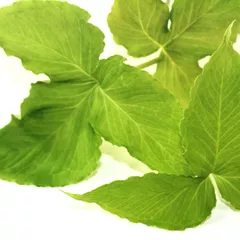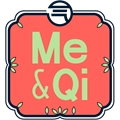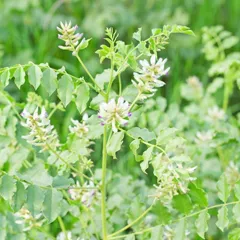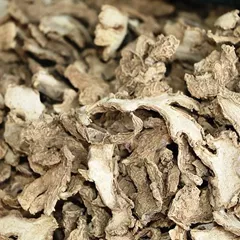Allergic rhinitis according to Chinese Medicine
The information provided here is not a replacement for a doctor. You shouldn't use it for the purpose of self-diagnosing or self-medicating but rather so you can have a more informed discussion with a professional TCM practitioner.
Allergic rhinitis factsheet
Possible causes and remedies:
Lung Qi Deficiency and Liver Qi Stagnation
Symptoms: Coughing Dizziness Headaches and four other symptoms
Recommended formula: Xiao Chai Hu Tang
Phlegm-Fluids above the diaphragm
Symptoms: Wheezing No thirst Absence of sweating and five other symptoms
Recommended formula: Xiao Qing Long Tang
In Chinese Medicine, allergic rhinitis can be associated with two so-called "patterns of disharmony". Chinese Medicine sees the body as a system, not a sum of isolated parts. A "pattern" is when the system's harmony is disrupted. It is not equivalent to the Western concept of "disease", as a matter of fact here allergic rhinitis can be caused by two different patterns.
To understand whether someone's allergic rhinitis might be caused by a given pattern, one needs to look for signs and symptoms associated with the pattern beyond what one might typically experience from allergic rhinitis alone. For instance when allergic rhinitis is caused by the pattern Lung Qi Deficiency and Liver Qi Stagnation, patients also experience symptoms such as coughing, hypochondrium fullness, dizziness and headaches. Similarly, patients with Lung Qi Deficiency and Liver Qi Stagnation typically exhibit empty (Xu) or tight (Jin) pulses as well as a normal (light red), pale tongue with thin white coating.
We've listed below a description of the two patterns associated with allergic rhinitis so that you can start to get an understanding of the various possibilities according to Chinese Medicine.
Once identified, patterns are often treated using herbal formulas. Drinking herbal infusions is the most common remedy in Chinese Medicine, together with acupuncture. Here we detail below fourteen formulas that can help treat the various patterns associated with allergic rhinitis, depending on which pattern fits your profile.
The two "patterns of disharmony" associated with allergic rhinitis

The Liver is a so-called "Zang" Organ. Learn more about the Liver in Chinese Medicine
Lung Qi Deficiency and Liver Qi Stagnation
Pulse type(s): Empty (Xu), Tight (Jin)
Tongue coating: Thin white coating
Tongue color: Normal (light red), Pale
Recommended herbal formula: Xiao Chai Hu Tang
Symptoms: Coughing Dizziness Headaches Depression Moving pain Listlessness Hypochondrium fullness
Allergic rhinitis might be due to Lung Qi Deficiency and Liver Qi Stagnation if the condition is paired with typical pattern symptoms such as coughing, hypochondrium fullness, dizziness and headaches. Similarly, patients with Lung Qi Deficiency and Liver Qi Stagnation typically exhibit empty (Xu) or tight (Jin) pulses as well as a normal (light red), pale tongue with thin white coating.
Read more about Lung Qi Deficiency and Liver Qi Stagnation here

Ephedra (Ma Huang) is the key herb for Xiao Qing Long Tang, a formula used for Phlegm-Fluids above the diaphragm
Phlegm-Fluids above the diaphragm
Pulse type(s): Floating (Fu), Tight (Jin)
Tongue coating: Thick white coating
Tongue shape: Swollen
Recommended herbal formula: Xiao Qing Long Tang
Symptoms: Wheezing No thirst Absence of sweating Generalized body pain Alternating fever and chills General sensation of heaviness Stifling sensation in the chest Coughing of copious thin and white sputum
Allergic rhinitis might be due to Phlegm-Fluids above the diaphragm if the condition is paired with typical pattern symptoms such as alternating fever and chills, absence of sweating, wheezing and stifling sensation in the chest. Similarly, patients with Phlegm-Fluids above the diaphragm typically exhibit floating (Fu) or tight (Jin) pulses as well as a tongue with thick white coating.
The fourteen herbal formulas that might help with allergic rhinitis



The top herbs in Xiao Chai Hu Tang are Bupleurum Roots (Chai Hu), Baikal Skullcap Roots (Huang Qin) and Crow-Dipper Rhizomes (Ban Xia)
Xiao Chai Hu Tang
Source date: 220 AD
Number of ingredients: 7 herbs
Key actions: Treats the Lesser Yang Channels (Gallbladder and Triple Warmer). Regulates the Liver and Spleen functions. Addresses combined Yin-Yang symptoms of External and Internal, Excess and Deficiency, and Hot and Cold.
Why might Xiao Chai Hu Tang help with allergic rhinitis?
Because it is a formula often recommended to help treat Lung Qi Deficiency and Liver Qi Stagnation, a pattern sometimes associated with allergic rhinitis. If it looks like you might suffer from Lung Qi Deficiency and Liver Qi Stagnation, this formula might help (although please seek confirmation with a professional practitioner beforehand).



The top herbs in Xiao Qing Long Tang are Ephedra (Ma Huang), Cinnamon Twigs (Gui Zhi) and Dried Ginger (Gan Jiang)
Xiao Qing Long Tang
Source date: 220 AD
Number of ingredients: 8 herbs
Key actions: Releases the Exterior. Transforms Phlegm-Fluids. Warms the Lungs. Directs Rebellious Qi downward.
Why might Xiao Qing Long Tang help with allergic rhinitis?
Because it is a formula often recommended to help treat Phlegm-Fluids above the diaphragm, a pattern sometimes associated with allergic rhinitis. If it looks like you might suffer from Phlegm-Fluids above the diaphragm, this formula might help (although please seek confirmation with a professional practitioner beforehand).



The top herbs in Li Zhong Wan are Dried Ginger (Gan Jiang), Ginseng (Ren Shen) and Atractylodes Rhizomes (Bai Zhu)
Li Zhong Wan
Source date: 220 AD
Number of ingredients: 4 herbs
Key actions: Warms the Middle Burner. Strengthens the Spleen and Stomach.
Why might Li Zhong Wan help with allergic rhinitis?
Because it is a formula often recommended to help treat , a pattern sometimes associated with allergic rhinitis. If it looks like you might suffer from , this formula might help (although please seek confirmation with a professional practitioner beforehand).



The top herbs in Ge Gen Tang are Kudzu Roots (Ge Gen), Ephedra (Ma Huang) and Cinnamon Twigs (Gui Zhi)
Ge Gen Tang
Source date: 220 AD
Number of ingredients: 7 herbs
Key actions: Releases the Exterior and muscle layer. Forms Body Fluids.
Why might Ge Gen Tang help with allergic rhinitis?
Because it is a formula often recommended to help treat , a pattern sometimes associated with allergic rhinitis. If it looks like you might suffer from , this formula might help (although please seek confirmation with a professional practitioner beforehand).



The top herbs in Gui Zhi Tang are Cinnamon Twigs (Gui Zhi), White Peony Roots (Bai Shao) and Fresh Ginger (Sheng Jiang)
Gui Zhi Tang
Source date: 220 AD
Number of ingredients: 5 herbs
Key actions: Releases pathogens from the muscle layer. Regulates the Nutritive and Protective Qi.
Why might Gui Zhi Tang help with allergic rhinitis?
Because it is a formula often recommended to help treat , a pattern sometimes associated with allergic rhinitis. If it looks like you might suffer from , this formula might help (although please seek confirmation with a professional practitioner beforehand).



The top herbs in Gan Cao Gan Jiang Tang are Dried Ginger (Gan Jiang) and Liquorice (Gan Cao)
Gan Cao Gan Jiang Tang
Source date: 220 AD
Number of ingredients: 2 herbs
Key actions: Warms the Lungs. Strengthens the Stomach.
Why might Gan Cao Gan Jiang Tang help with allergic rhinitis?
Because it is a formula often recommended to help treat , a pattern sometimes associated with allergic rhinitis. If it looks like you might suffer from , this formula might help (although please seek confirmation with a professional practitioner beforehand).



The top herbs in Jing Jie Lian Qiao Tang are Japanese Catnip (Jing Jie), Forsythia Fruits (Lian Qiao) and White Peony Roots (Bai Shao)
Jing Jie Lian Qiao Tang
Source date: 1773 AD
Number of ingredients: 13 herbs
Key actions: Dispels Wind. Clears toxic-Heat. Disperses Stagnation.
Why might Jing Jie Lian Qiao Tang help with allergic rhinitis?
Because it is a formula often recommended to help treat , a pattern sometimes associated with allergic rhinitis. If it looks like you might suffer from , this formula might help (although please seek confirmation with a professional practitioner beforehand).



The top herbs in Ma Huang Xi Xin Fu Zi Tang are Ephedra (Ma Huang), Prepared Aconite (Zhi Fu Zi) and Wild Ginger (Xi Xin)
Ma Huang Xi Xin Fu Zi Tang
Source date: 220 AD
Number of ingredients: 3 herbs
Key actions: Tonifes the Yang. Releases the Exterior.
Why might Ma Huang Xi Xin Fu Zi Tang help with allergic rhinitis?
Because it is a formula often recommended to help treat , a pattern sometimes associated with allergic rhinitis. If it looks like you might suffer from , this formula might help (although please seek confirmation with a professional practitioner beforehand).
Xin Yi Qing Fei Yin
Source date: 1617
Number of ingredients: 10 herbs
Key actions: Spreads Lung Qi. Clears Heat. Unblocks the orifices (specifically the nose) .
Why might Xin Yi Qing Fei Yin help with allergic rhinitis?
Because it is a formula often recommended to help treat , a pattern sometimes associated with allergic rhinitis. If it looks like you might suffer from , this formula might help (although please seek confirmation with a professional practitioner beforehand).



The top herbs in Su He Xiang Wan are Styrax (Su He Xiang), Musk (She Xiang) and Borneol (Bing Pian)
Su He Xiang Wan
Source date: 752 AD
Number of ingredients: 15 herbs
Key actions: Warms and aromatically opens the sensory orifices. Promotes the movement of Qi. Transforms turbidity.
Why might Su He Xiang Wan help with allergic rhinitis?
Because it is a formula often recommended to help treat , a pattern sometimes associated with allergic rhinitis. If it looks like you might suffer from , this formula might help (although please seek confirmation with a professional practitioner beforehand).



The top herbs in Cang Er Zi San are Cocklebur Fruits (Cang Er Zi ), Biond’S Magnolia Flowers (Xin Yi Hua) and Angelica Roots (Bai Zhi)
Cang Er Zi San
Source date: 1253
Number of ingredients: 5 herbs
Key actions: Disperses Wind. Relieves pain. Unblocks the nose.
Why might Cang Er Zi San help with allergic rhinitis?
Because it is a formula often recommended to help treat , a pattern sometimes associated with allergic rhinitis. If it looks like you might suffer from , this formula might help (although please seek confirmation with a professional practitioner beforehand).



The top herbs in Bu Fei Tang are Ginseng (Ren Shen), Milkvetch Roots (Huang Qi) and Schisandra Berries (Wu Wei Zi)
Bu Fei Tang
Source date: 1331 AD
Number of ingredients: 6 herbs
Key actions: Augments the Qi. Stabilizes the Exterior.
Why might Bu Fei Tang help with allergic rhinitis?
Because it is a formula often recommended to help treat , a pattern sometimes associated with allergic rhinitis. If it looks like you might suffer from , this formula might help (although please seek confirmation with a professional practitioner beforehand).



The top herbs in Yu Ping Feng San are Milkvetch Roots (Huang Qi), Atractylodes Rhizomes (Bai Zhu) and Saposhnikovia Roots (Fang Feng)
Yu Ping Feng San
Source date: 1213 AD
Number of ingredients: 3 herbs
Key actions: Augments the Qi. Stabilizes the Exterior. Stops sweating .
Why might Yu Ping Feng San help with allergic rhinitis?
Because it is a formula often recommended to help treat , a pattern sometimes associated with allergic rhinitis. If it looks like you might suffer from , this formula might help (although please seek confirmation with a professional practitioner beforehand).



The top herbs in Xin Yi San are Biond’S Magnolia Flowers (Xin Yi Hua), Bugbane Rhizomes (Sheng Ma) and Chinese Lovage Roots (Gao Ben)
Xin Yi San
Source date: 1253 AD
Number of ingredients: 9 herbs
Key actions: Disperses Wind-Cold. Unblocks the nasal passages.
Why might Xin Yi San help with allergic rhinitis?
Because it is a formula often recommended to help treat , a pattern sometimes associated with allergic rhinitis. If it looks like you might suffer from , this formula might help (although please seek confirmation with a professional practitioner beforehand).
Symptoms related to allergic rhinitis
Coughing Hypochondrium fullness Dizziness Headaches Depression Listlessness Moving pain Alternating fever and chills Absence of sweating Wheezing







